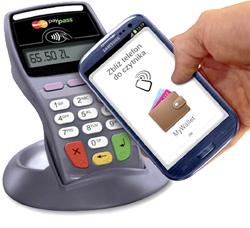 IT’S BEEN A HALF-DECADE since I first got religion about the potential for “contactless payments” using NFC-enabled wallets in mobile phones. A very bright entrepreneur brought the concept to my attention and asked me to help advise his new firm. I agreed and got myself launched up the learning curve.
IT’S BEEN A HALF-DECADE since I first got religion about the potential for “contactless payments” using NFC-enabled wallets in mobile phones. A very bright entrepreneur brought the concept to my attention and asked me to help advise his new firm. I agreed and got myself launched up the learning curve.
Most readers probably know that NFC (near-field communications) is a form of wireless radio that works only across a few centimeters. It’s perfect for enabling a mobile phone to communicate securely with a point of sale terminal. If the phone has an NFC chip and wallet app installed, a tap can function as a substitute for a card-swipe to enable payments and even frequent-shopper redemptions in a few milliseconds.
Mobile wallets are gaining traction throughout the developed world. The image reproduced here documents Eurobank’s version in Poland. Here in the U.S. we observe a slower pace of development, although the recent launch of Apple Pay seems to have kicked up the interest. Then again, yesterday’s disclosure of a data breech affecting the competing CurrentC service from Merchant Customer Exchange (MCX) has a lot of heads shaking.
A discussion about these matters today on RetailWire.com got me wondering why so much time has elapsed without widespread acceptance of NFC wallets in smartphones. Here’s my take:
Adoption of NFC-enabled wallets seems to be moving ahead slowly in the U.S. Besides CurrentC and Apple Pay, Google Wallet and Softcard (formerly ISIS) are also engaged in market tests. NFC-enabled card readers are showing up at more POS locations due (I think) to routine replacement cycles, but merchant acceptance is spotty.
Yes, the CurrentC email hack looks bad, but I think there are other reasons why contactless payments are not setting the world on fire. One is limited store coverage. Another may be shopper anxiety about loading their credit and debit card information into a mobile app on a device that is easily lost. If you have to carry a regular wallet full of cards as a backup, the benefits may be seriously diluted.
Bottom line is that mobile wallets are not yet a practical, everyday solution for consumers. The providers are and will be tempting targets for hackers. With $trillions worth of transactions on the line, the banking establishment has plenty of reason to try to outmaneuver the upstarts too.
© Copyright 2014 James Tenser
